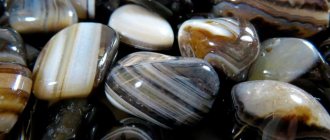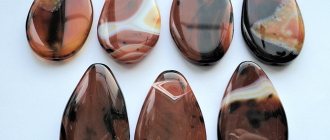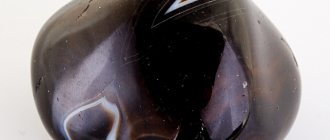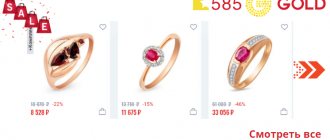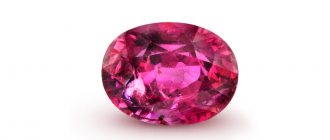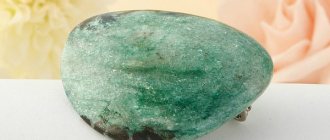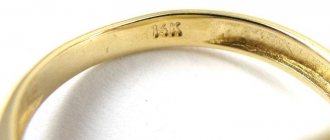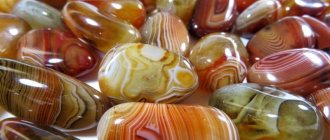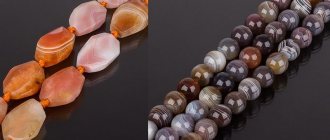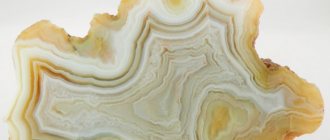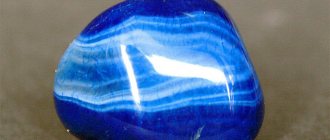It has been known for more than 6,000 years and has over 150 varieties. A rich palette of shades, intricate patterns and the possibility of decorative processing have made agate popular among craftsmen of past centuries and our time.
According to one version, the name of the stone comes from the Greek word “agates” - magical. Obviously, this is due to the fact that the stone often became an amulet for travelers and lovers.
What do we know about the amazing creation of nature - agate?
Interesting properties of agate
Agate belongs to the quartz group and is one of the varieties of chalcedony. The stone is of volcanic origin and has many impurities. This explains the striped layered color of some agates. If layers of any other color alternate with white layers, the stone can already be considered a separate variety of agate and receive its own name.
Based on the width of the layers, finely banded (from 0.5 to 1 mm), broadly banded (more than 1 mm), coarsely banded (more than 10 mm) and differently banded (from 0.5 mm to several cm) agates are distinguished.
The stone is quite hard (6.5-7 on the Mohs scale), mostly opaque, easy to process, and resistant to acids.
Varieties of agate
Frosty, star-shaped, landscape, cloudy, woody, tortoiseshell, ruinous... All these poetic words are the names of varieties of agate. Their colors resemble clouds floating across the sky, ruined ancient castles, forest moss or spreading tree branches.
The formation of the stone remained a mystery for a long time. Agate has many varieties that differ in color, arrangement of layers, types of inclusions, structure and many other characteristics.
Solid agates get their name due to their color. This is how the well-known white, black, blue (or sapphirine) types of stone appeared.
The name of some types, for example, banded, dotted, feathery, iridescent or ocellated agate, is explained by the structure of the stone.
Agate mining and deposits
Agate deposits are found in many countries on almost all continents. Until the beginning of the 19th century, the stone was mined mainly in Germany. Now the largest deposits are located in Brazil and Uruguay, Mongolia, Georgia and Armenia. In Russia, agate is mined in the Urals, Transbaikalia and Crimea.
Small samples (about 1 cm) are found in surface rock deposits. But finding a mineral larger than 20 cm is very rare.
Top 5 interesting facts about agate
- Agate was first described in the scientific treatise of Theophrastus “On Stones” in 372-287. BC.
- For 1 cm of thickness of Brazilian agate there are up to 8,000 alternating layers of color.
- Until the beginning of the 19th century in the Urals, all red rocks with black, white and cherry inclusions were called agates.
- In ancient Egypt, travelers who needed to cross the desert took agate with them. A piece of stone was sucked like a lollipop, and it saved them from tormenting thirst.
- There are currently two unique agates. A bowl with a diameter of 75 cm was made from one of them (Vienna, Hofburg treasury). The second is a cameo brooch of Princess Maria Pavlovna, daughter of Paul I (State Repository of Russian Valuables).
Jewelry with agate
Nowadays, agate is experiencing a rebirth. Despite its status as an ornamental stone, it is used in jewelry made of precious metals and is combined with semi-precious and precious inserts, including diamonds.
Various types of cuts (cabochon, marquise, cushion and others) emphasize the beauty of the stone, its special opaque structure, and noble matte shine.
Jewelry with agate looks self-sufficient and modern, and makes it possible to look stylish even without a special occasion.
History and origin
Agate is a stone of volcanic origin. It is believed that it was first found on the island of Sicily, near the Achates River. The name of the stone was given to the place where it was discovered. Although another version of the legend claims that the mineral got its name from the Greek “agathos” - kind, happy.
Agate stone
By nature, it is a type of chalcedony, which in turn is a type of quartz. Description: Alternating layers of contrasting colors, objects in the form of ellipses and stars, mosaic or kaleidoscopic images reminiscent of the ruins of ancient cities, and even misty figures reminiscent of plants are all agate. But ironically, the true beauty of a stone can only be seen through its cut or fracture. Outwardly, it is a completely unremarkable pebble.
The amazing internal coloring, inexplicable from the point of view of the ancients, gave rise to an abundance of legends and rumors associated with this stone.
A gem with an eye design was often called the “Eye of God,” sometimes specifying that it meant Vulcan or Pluto. In Renaissance Italy, this stone was revered as a symbol of masters of the artistic arts - jewelers, cutters, stone carvers, sculptors and artists.
The importance of agate was so great that products made from it - dishes, bowls, figurines - with proper craftsmanship were considered worthy of decorating the chambers of emperors. It is known that agate was valued in the courts of at least two European rulers - the Basileus of Byzantium and, a couple of centuries later, the Austrian Habsburg dynasty. The characteristics of the stone allow for very fine processing, achieving a strong artistic effect, therefore in ancient times it was classified not as an ornamental stone, but as a precious stone.
Alchemists of the Middle Ages believed that an agate mortar and pestle was the best tool for grinding various substances. They turned out to be right: thanks to the combination of physical properties - hardness at the same time as viscosity and strength - agate is still used to make dishes for chemical laboratories in our time.
Black agate, how to distinguish a fake - recommendations from experts
Agate is considered the most popular and in demand ornamental stone in the jewelry industry. It has various shades of all colors, but the most mysterious and mystical is still black agate.
What is natural black agate?
Any imitation involves the use of plastic, glass or crumbs, which are coated with dyes or special chemical compounds. However, there are several basic ways to distinguish a natural gem from an artificial one.
Black agate of natural origin is considered an excellent talisman for its owner and has magical and healing properties. Since ancient times, a legend has appeared that the color black gives courage and strength to a person, and it is advisable to wear it in the form of a pendant or earrings.
Jewelers artificially color the mineral. In this case, the agate is cleaned and placed in a hot solution with added sugar. It is then cleaned again and calcined with sulfuric acid. The black color is obtained by heating the gem with special chemical solutions.
Methods for determining the authenticity of black agate
Black agate also successfully identifies ill-wishers and deceivers, a person becomes truly perspicacious, intuitively senses lies and negative influences.
Visual
Fake black agate can be identified visually. You should carefully examine the mineral and the pattern of the gem. Natural stone has a not too bright shade with smooth, blurry transitions. Artificial stones have a rich and bright color, which is obtained due to coloring with chemical compounds.
There are other methods for identifying a fake by color:
- The color of a natural gem is radically different from the shade that is obtained due to processing by a jeweler. That is why you should pay close attention to the shade of the stone.
- Too high contrast and sharp transitions indicate the artificial origin of the nugget. If the black color is glossy, bright, and has a strong shine, then it is advisable not to purchase such a product, most likely it is a fake.
- Solid color without transitions or lines also shows processed decorations.
- The fracture of the agate is matte, and after processing the mineral looks like a glass product.
- The natural mineral is opaque, but when looked at in the light you can see the finest strips and plates.
- If a person is going to purchase a product with agate, then he needs to pay close attention to the edges. In painted products they are distinguished by their brightness and shine, but natural stones are uniform over the entire surface.
It is advisable to compare the brightness of the shades on the front and back. Typically, fake minerals are colored only on the front, leaving the other part natural.
By heating
Everyone understands that precious minerals of natural origin heat up over a long period of time. To distinguish an agate from a fake, you should hold it in your hand and hold it. The artificial product will instantly heat up, and the natural product will remain cold for several minutes, giving you coolness.
The black nugget has the highest value; it is constantly counterfeited. You can try running a needle over it. If the stone is created by pressing, it will immediately begin to crumble, and traces of physical impact will remain on it.
Using water
You can identify natural agate by putting it in water for a while. You need to lower the stone halfway, then pull it out and compare both parts after a few hours. If the mineral is of natural origin, it will remain homogeneous and retain its color. Well, if the color scheme has changed, the brightness has also changed, then the person is faced with a fake.
If a person is going to purchase jewelry with black agate, then there is a possibility of encountering a fake. You can ask the seller to scratch the stone a little with a needle. If he refuses and begins to resist, then the stone was obtained artificially. Real agate is highly durable and is quite difficult to scratch.
If a person doubts the authenticity of the jewelry, then it is advisable to refuse the purchase. Artificial stones not only will not bring any benefit, but can harm the new owner. Chemical exposure may cause allergic reactions.
How is natural agate counterfeited?
Today, jewelers have made significant progress in creating fake jewelry. It is almost impossible to detect artificial coloring by eye. Chemical processing and glass are often very similar to natural minerals, as a result, buyers purchase fake jewelry.
Some can create fakes even at home. They look like real minerals, even reflecting the crystalline structure of a natural gem. You should not trust your own vision; it is advisable to use some testing methods, try to heat the stone.
How to determine the authenticity of an agate?
Eleonora Brik
Ornamental materials with intricate patterns and wonderful jewelry stones are not always of natural origin. To recognize a fake, you need to know some criteria that are unique only to natural stones. It is recommended to remember a few tips, then the chances of being deceived will be much less. All jewelry has a “right to life,” but it is important for the buyer to know about the true origin of the materials and not overpay for imitations.
Gold earrings with diamonds, topaz and black agates, SL; gold ring with diamonds, topazes and black agates, SL (price on the link)
How to counterfeit natural agate
The layered variety of chalcedony is famous for its richness of shades and patterns, although minerals in gray-blue tones are more common. Natural agate is mined in Russia, China, Brazil, India and other countries. Jewelry and interior details made from this popular jewelry and ornamental stone look very attractive. If not for one “but”...
The authenticity of the gems is questionable, and not without reason. The market is flooded with imitation semi-precious stones made from plastic and resin. But how can a buyer distinguish natural agate from its fakes in order to enjoy its natural beauty? You should be prepared for the fact that bright and cheap semi-precious stones will turn out to be fakes.
Tinted agates are minerals that have been treated with chemicals to enhance natural color or produce a sought-after color.
Artificial - created from stone chips; synthetic ones are made from plastic and glass.
Natural stones are treated with solutions of acids and alkalis, and metal salts. Black and brown agate are obtained by keeping the mineral in sugar syrup followed by treatment with sulfuric acid. They combine dyeing with firing or other types of heat treatment. Contrasting temperatures cause cracks to appear, and filling them with paint gives a “moss” or “dragon vein” effect.
How to distinguish a fake agate from a natural stone
Knowing how to check the authenticity of a mineral, it is easier to avoid embarrassment and waste. There are many who want to become owners of valuable varieties of agate with an unusual mossy and ocular texture. Others are attracted by black and white stones, behind which there is a trail of legends about magical properties.
When choosing talisman stones and amulets made of agate, take into account the existence of fakes. The true color of a natural mineral may differ from the color it acquires after processing to make rosaries, beads, rings and bracelets.
Gold pendant with diamonds and white agate, SL; gold earrings with diamonds and white agate, SL; gold ring with diamonds and white agate, SL (prices follow links)
How to determine the authenticity of an agate - instructions:
- Color. The contrast of inclusions and sharp transitions are uncharacteristic of natural stone. Therefore, first of all, pay attention to the intensity of the color, the rich color scheme. Reason for doubt is the pure black color, unnaturally bright shades for agate (green, bright blue, purple, crimson, lemon). Another property of fakes is that they are monochromatic, without stripes or lines.
- Shine and transparency. If you can see the fracture, it will be matte in the agate. Polished stone acquires a glassy shine. Agate is opaque, but its thin plates are translucent.
- Temperature. Agate heats up slowly, like other natural stones. If you apply natural agate to the inner bend of your elbow or wrist, you will feel coolness for at least 30 seconds. Glass and plastic heat up in a matter of seconds.
- Hardness. The hardest mineral is diamond (10 on the Mohs scale). Natural agate also has relatively high hardness (6; 7) and leaves scratches on glass. Stone made from pressed chips is fragile. When pressed with a sharp needle, pieces will break off (conduct the test on an inconspicuous part of the decoration).
- Solubility. Dip half the pebble in water and leave for 2-3 hours. If the part that was in the liquid has changed color or faded, then the agate is of artificial origin. Genuine precious and semi-precious stones do not dissolve in water. Agate is not affected by many acids.
Tinted, artificial and synthetic agates may be harmful to the health of the owner due to the presence of foreign chemicals.
- the acquired skills of recognizing counterfeits directly in a store or boutique. If you find a fake at home, take it back to the seller.
It is recommended to refrain from purchasing if the stone does not meet the characteristics listed above. The cheapness of a mineral with an unusual pattern should raise suspicions. Agates with an original pattern belong to the same class of precious stones as amber and turquoise.
To avoid crude fakes, use the instructions “How to determine the authenticity of an agate.” However, the option of contacting a professional gemologist or gem appraiser cannot be ruled out. This step is important for those who want to acquire a talisman using natural agate, replenish a jewelry box or their collection of minerals.
Varieties and colors
It is impossible to clearly state what color an agate is. This mineral has many faces, like nature itself: there are white-brown, white-blue, yellow, pink, even black and bright blue varieties. Moreover, many common subspecies have their own names, such as onyx, sardonyx and sapphirine.
Agate jewelry
A specific variety of agate is determined by the pattern on the saw blade and the combination of colors. Primary colors:
- brown;
- blue or blue;
- yellow-brown;
- pink;
- grey;
- greenish;
- shades of red or carmine.
Black agate is less common.
Subspecies of agate such as onyx and sardonyx are considered independent stones in gemology. Onyx is distinguished by parallel layers of contrasting colors, such as white and blue, white and brown, and so on. And sardonyx is an alternation of red, orange, carmine and yellow layers that can form various shapes - “pupils”, stars and so on.
A rare blue variety is called sapphirine.
Sapphirine stones
In addition to the variety of colors, agates are classified according to the pattern on the fracture or cut. Interspersed with various elements can form figures there that resemble natural landscapes, city outlines, ruins of fortresses, tree branches or imprints of ancient petrified moss. Some stones when cut resemble the shells of prehistoric fossilized mollusks, and sometimes fossil cephalopods actually turn out to be part of the agate.
The classification by type speaks for itself:
- star;
- banded;
- landscape or landscape;
- bastion or ruin;
- flywheel;
- dendrite;
- floral;
- frosty;
- disk;
- iridescent;
- fiery;
- rainbow.
Separately, it is worth noting flywheel, dendrite and flower agate. The first has an amazing pattern, reminiscent of black northern moss on a light background. On the cut of the second one you can see a picture that suggests dense forest thickets. Floral - something between the first and second; on the cut of such a specimen you can see a fancy flower.
This list is far from complete. Each deposit is distinguished by its own “signature” stone pattern. Green ones with a brown pattern, for example, are mined in India, black and white striped ones are found in the mountains of Tibet, and specimens with “pupils” of alternating brown, white and gray stripes are brought from Brazil.
How to distinguish agate from a fake?
Agate can rightfully be called one of the most famous and sought-after ornamental stones. The variety of shades is amazing, it comes in all colors from cream to black, there are even transparent varieties.
Since ancient times, it has been valued for its unique combinations of shades and unique patterns.
Today, manufacturers have learned to create very high-quality fakes, replenishing the shelves of jewelry departments with all kinds of products.
Any imitation is based on glass, plastic or chips, which are coated with special paint or dyes that create a feeling of authenticity. How to distinguish natural agate from an artificial fake?
How to distinguish a fake agate?
Agate, especially the black variety, is not only a wonderful decorative gem, this mineral is considered a powerful talisman with magical properties.
Since ancient times, there has been a legend about the strength and courage that it gives to its owner. It is best worn as a pendant or earrings.
How to distinguish a black agate stone from a fake? There are 5 main methods for determining imitation, regardless of color:
- After purchasing a product, check its durability. Most often, pressed chips formed into a bead are passed off as a natural gem. Small grains of real stone are quite fragile, so if, after pressing on the jewelry with a needle, it begins to crumble, then this is a fake.
- How to distinguish a fake black agate? The gem has a naturally heterogeneous structure, and even in a black stone you can see some impurities of other metals, usually red or white.
- Like any other natural stone, it has low thermal conductivity, which means that when you pick it up, it will remain cool for a long time, regardless of the surrounding temperature.
- Often the mineral does not have a bright shine, but rather a matte tint. In order to refine it, it is treated with various chemicals, due to which it acquires not only a pleasant shine and rich shade, but also other colors that are not characteristic of the mineral. If you think the color is too bright, then there is a chance that you are looking at a fake or imitation.
- You can determine the naturalness of a gem and find out whether it has been colored using water. Put it in water overnight, and if in the morning it becomes cloudy and dull or the paint has come off, then it is definitely not an original decoration.
When purchasing products and accessories inlaid with precious or semi-precious gems, pay attention to the presence of documents confirming the authenticity and identifying the deposit of the stone. Make purchases only from stores you trust.
The Mineral Market online store provides a wide range of precious and ornamental stones. By visiting mineralmarket.ru, you will learn all the information about minerals, their magical and healing properties, learn to distinguish a genuine product from a fake and be able to choose an individual talisman in accordance with your name, date of birth or zodiac sign.
How to distinguish agate from a fake
Agate is not considered a gemstone. However, it has an unusual appearance. And if a good craftsman treats it, polishes it and gives it shine, then it will sparkle with new colors.
Black agates are of particular interest to the public. They attract the eyes of those around them with their depth of color and shimmer. It is not for nothing that magical actions are associated with agates.
Their owners are credited with increasing self-confidence and courage.
Today, under the guise of agate, an artificial imitation of it can be included in a product. Or elements created from crumbs left after processing the mineral itself.
In addition, to add brightness and richness to the colors of agate, it is often subjected to various tests: dipped in alkaline solutions and acids, treated with salts of various metals.
In addition to chemical influences, the stone goes through high and low temperatures. This allows you to achieve a special pattern - moss or dragon veins.
Artificial agates are made from glass, plastics, and epoxy resin. The rules for calculating fakes are quite simple. They are easy to remember and then put into practice.
Thermal conductivity
Rule 1. You should remember the low thermal conductivity of minerals. Agate is no exception. Hold the stone in the crook of your elbow. Pay attention to how long it will feel cool in this place. If it takes longer than half a minute, then the stone is natural. Plastics and glass will warm up in ten seconds.
By the way, read this article too: What is the difference between Moissanite and Diamond
Hardness
Rule 2. This rule will help if you like a product with black agate. Since there is a possibility that fakes are made from crumbs, ask the seller to scratch the stone with a needle in an inconspicuous place. If it starts to crumble, then it is clear that the insert is artificial.
Real agate has high hardness, which means it is not so easy to scratch. Rather, he himself will leave scratches on the glass. By the way, maybe you won’t have to scratch the mineral at all. Watch the seller's reaction when you voice your request.
If he starts putting forward arguments not to scratch the stone, then it is better to refuse to buy the product.
Color fastness
Rule 3. This verification method is suitable for an already purchased agate product. You need to place the mineral in water for a couple of hours until it reaches the middle. If, over time, the appearance of the wet half has not changed, then the sample is real. Fakes usually stain the water, lose color brightness and shine. If something like this happens to your mineral, take it back to the store.
Color
Rule 4. Always carefully examine the agate you are interested in. The main color should not be bright or unnatural green, purple and red. There must be veins, and with a smooth transition, without sharp boundaries. Even black agates come with yellow or red lines. There are no pure black natural agates.
By the way, read this article too: How to distinguish real quartz from a fake
Cracks
Rule 5: Colored agates can be recognized when viewed through a microscope. Since the mineral always has minor cracks, paint will clog in them in large volumes. When enlarged, such bright areas will immediately catch the eye.
Uniformity
Rule 6. If you decide to purchase the agate mineral directly, then pay attention to its edges.
Painted samples have bright edges, while in natural minerals the edges are of a dull color, uniform throughout the entire perimeter. Moreover, not only the edges on the front side are painted, but also the side surface.
Compare also the brightness of the colors on the polished side and the back. Most often, only the front part is painted. And the back remains natural color.
Certificates
While in the store, ask the seller if the product you like has a certificate. The agate imitations themselves are not so bad. You just need to know for sure what you are paying money for.
After all, real agate has special properties, while nothing should be expected from a fake except decoration.
And if the agate is tinted, then it is not yet known how your body will react to certain dyes, alkalis and salts with which such a specimen is impregnated.
Therefore, you should not allow the seller to deceive you.
We learn how to distinguish a fake agate from the original
Agree that you don’t want to overpay for imitation natural stone. Moreover, when you are counting on a real stone, but it turns out that the agate is a fake, we’ll tell you right now how to distinguish them and not get into trouble.
What is natural agate and what does it look like?
Agate is a layered variety of chalcedony. The stone is characterized by a huge number of shades, varieties of patterns and smooth transitions. However, most often agate has a gray-blue color and its tones.
Compatibility with other stones
Agate jewelry is best combined with products made from other stones of the earth or water elements.
Neighborhood with Air stones is neutral; there will be no harm or benefit.
Agate (all varieties) can be worn simultaneously with:
- nephritis;
- lapis lazuli;
- jasper;
- cacholong;
- morion;
- emerald;
- opal;
- peridot;
- aventurine;
- malachite.
Bracelet made of agate and jade
Neutral is the combination with Air gems, which include the following:
- rhinestone;
- smoky quartz;
- topaz;
- amethyst;
- sapphire;
- blue chalcedony.
Agate is incompatible with any Fire stones, primarily with ruby, pyrope, garnet, diamond (diamond), and also coral.
How to determine the authenticity of an agate in a ring - Komiinform
How to determine the authenticity of an agate in a ring
Agate is a semi-precious stone with a unique pattern and natural hue. It can be red, white, black, blue-gray, pink and even green.
There are synthetic versions of the gem, which are created from stone chips in the laboratory. And also fakes - gems that look similar in appearance, but are made of plastic or glass.
How to choose a ring with agate so as not to buy glass? Let's look at a few simple verification methods.
A type of natural semi-precious agate
You can get an original and not a fake if you buy jewelry in jewelry stores. Each gold or silver agate ring must be accompanied by a special tag. It indicates the carat size of the stone, the type of precious metal and information about the manufacturer.
But if you still doubt the authenticity of the agate you purchased, you can check it at home. For this:
- Pay attention to the color. Contrasting bright inclusions and sharp changes in shades are not typical for a natural mineral. Too intense colors are also uncharacteristic of nature. Rich black, green, bright blue, purple should alert you.
- Matteness is a distinctive feature of agate. Upon close examination, it can be seen even in a processed stone, which receives a glassy sheen due to cutting.
- Gradual heating. Most natural nuggets do not heat well. It is enough to rub the stone in your hands to understand whether it is plastic or mineral.
- Natural agate has a hardness of 6–7 on the Mohs scale. If you drag a ring with agate across glass, the scratch will not be on the jewelry, but on the glass surface.
These four tips are already enough to identify a fake. Additionally, you can put the decoration in a glass of plain water. The natural nugget will remain unchanged. But a fake can color the water and become more transparent.
Cost and advice
It is also worth considering weight. Both glass and plastic are much lighter than natural stones. Pay attention to the price. The average cost of black agate weighing 4.3 grams is from 900 rubles. That is, a silver ring with such an insert will cost at least 1,800 rubles.
Plum agate weighing 17.3 g, mined in Kazakhstan, costs about 990 rubles. The Dzhambul nugget costs several times more - from 2300 rubles. for a large gem, weighing 48 g.
And always remember the main rule of buying jewelry: buy even the simplest things only from jewelers. Don’t think that the souvenir shop will actually sell you precious alloys with natural minerals.
As an advertisement
21.11.2019
On this day in 1944, Soviet troops liberated the city of Leningrad from the blockade of Nazi troops.
Zodiac compatibility
Agate's horoscope compatibility is almost perfect. It is suitable for almost all zodiac signs, although it especially “loves” Taurus, Cancer and Gemini.
But to say which zodiac sign agate suits best, you need to take into account the color of the mineral. Reddish and pink stones are optimal for earth signs - Taurus and Virgo, brown and bright red - for fire signs. A gray or blue stone is suitable according to the horoscope of a resident of the water element, for example, Cancer. But the black mineral in the zodiac circle most closely corresponds to Scorpio.
| Zodiac sign | Compatibility (“+++” – fits perfectly, “+” – can be worn, “-” – strictly contraindicated) |
| Aries | — |
| Taurus | + |
| Twins | +++ |
| Cancer | +++ |
| a lion | + |
| Virgo | + |
| Scales | + |
| Scorpion | + |
| Sagittarius | — |
| Capricorn | + |
| Aquarius | + |
| Fish | + |
(“+++” – fits perfectly, “+” – can be worn, “-” – is strictly contraindicated)
How to determine the authenticity of an agate
Agate is a semi-precious stone, a layered variety of chalcedony. It is very decorative due to its multi-colored striped structure and is a valuable jewelry and ornamental raw material. The stone has long been attributed healing and magical properties.
Natural agates are most often gray and blue, but other shades are also found. The stone is often painted to obtain a brighter color and clearer pattern, and is also imitated from glass or plastic.
Therefore, being able to determine the authenticity of an agate can be useful.
Painted agates appeared in ancient times: the stones were kept in honey and then calcined in a furnace. Nowadays, various chemical compounds are used for coloring, not nearly as harmless as honey.
Ferric nitrate gives the agate a rich red color, hydrochloric acid - yellow, chromium salts - green, potassium ferrocyanide and iron sulfate - shades of blue. It is unlikely that after such aggressive treatment, agate will retain its healing and magical properties. Therefore, when buying agate, pay attention to the color.
If it is too bright, acidic, and the layers are too contrasting, then the stone is artificially colored. It is better to refrain from purchasing.
How to distinguish natural agate from a fake?
Agate counterfeits are often made from glass and plastic. Glass with the addition of coloring substances, when cut using a certain cutting method, is difficult to distinguish from natural agate. Imitations of stone made of plastic are made even at home from multi-colored translucent polymer clay.
It is shaped, cut, baked in the oven and polished. With a little experience and imagination, you can recreate both the internal crystalline structure of agate and the multi-colored layers. To recognize counterfeits made of glass or plastic, squeeze them in your hand.
They will heat up quickly, while natural stone should remain cold.
Imitations of black agate made from pressed stone chips are very often found on sale. It is believed that the magical properties of black agate are unusually strong; it gives the owner strength, fortitude and power over evil. It is not difficult to guess that pressed and painted stone chips do not have these properties.
When purchasing beads, bracelets or rosaries made of black agate, keep in mind that the natural stone is always layered and does not have a uniform color. Stripes of different shades of black can be combined with white, gray, and red. Try scratching the needle near the hole of the bead.
Pressed agate is fragile and will crumble and chip.

